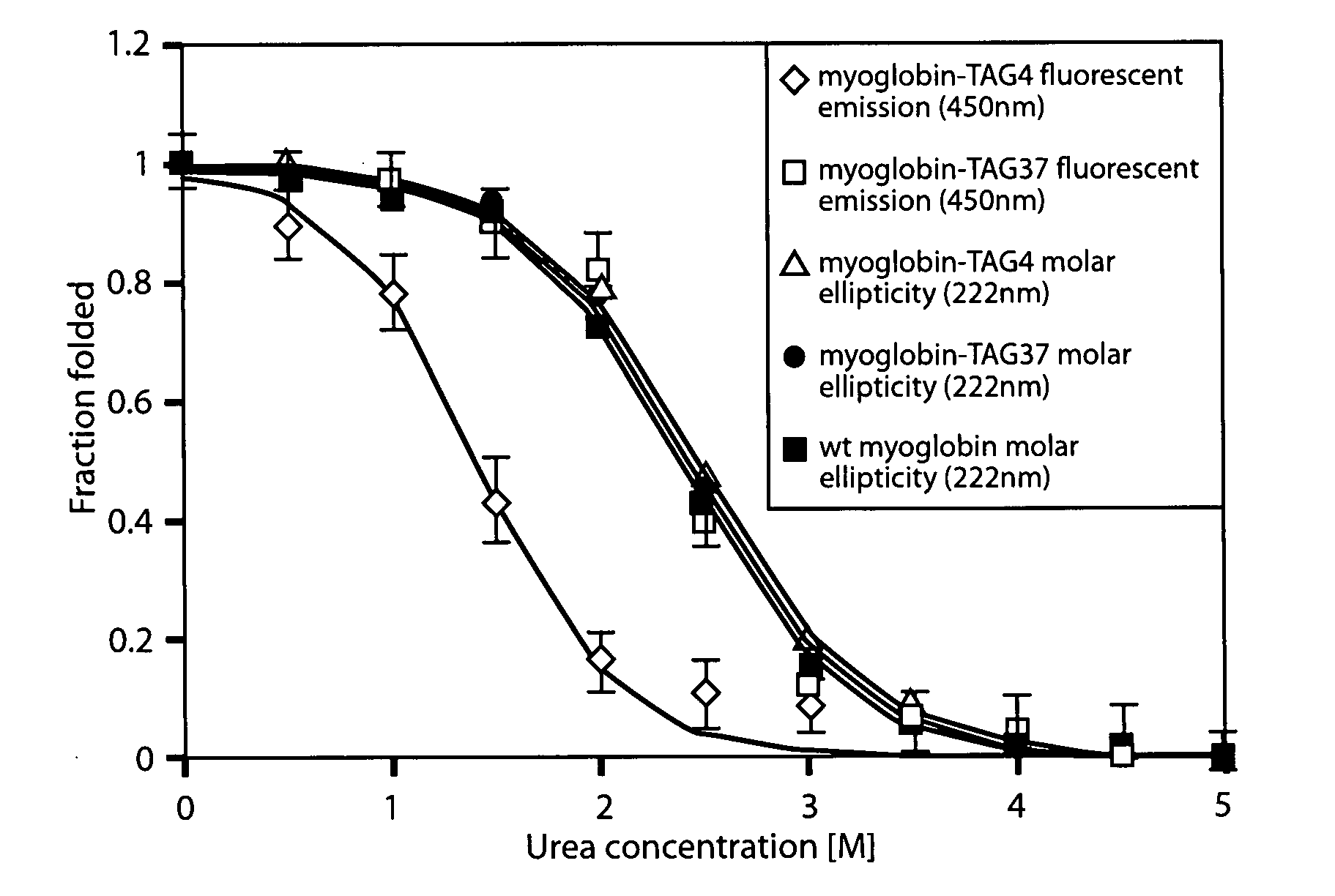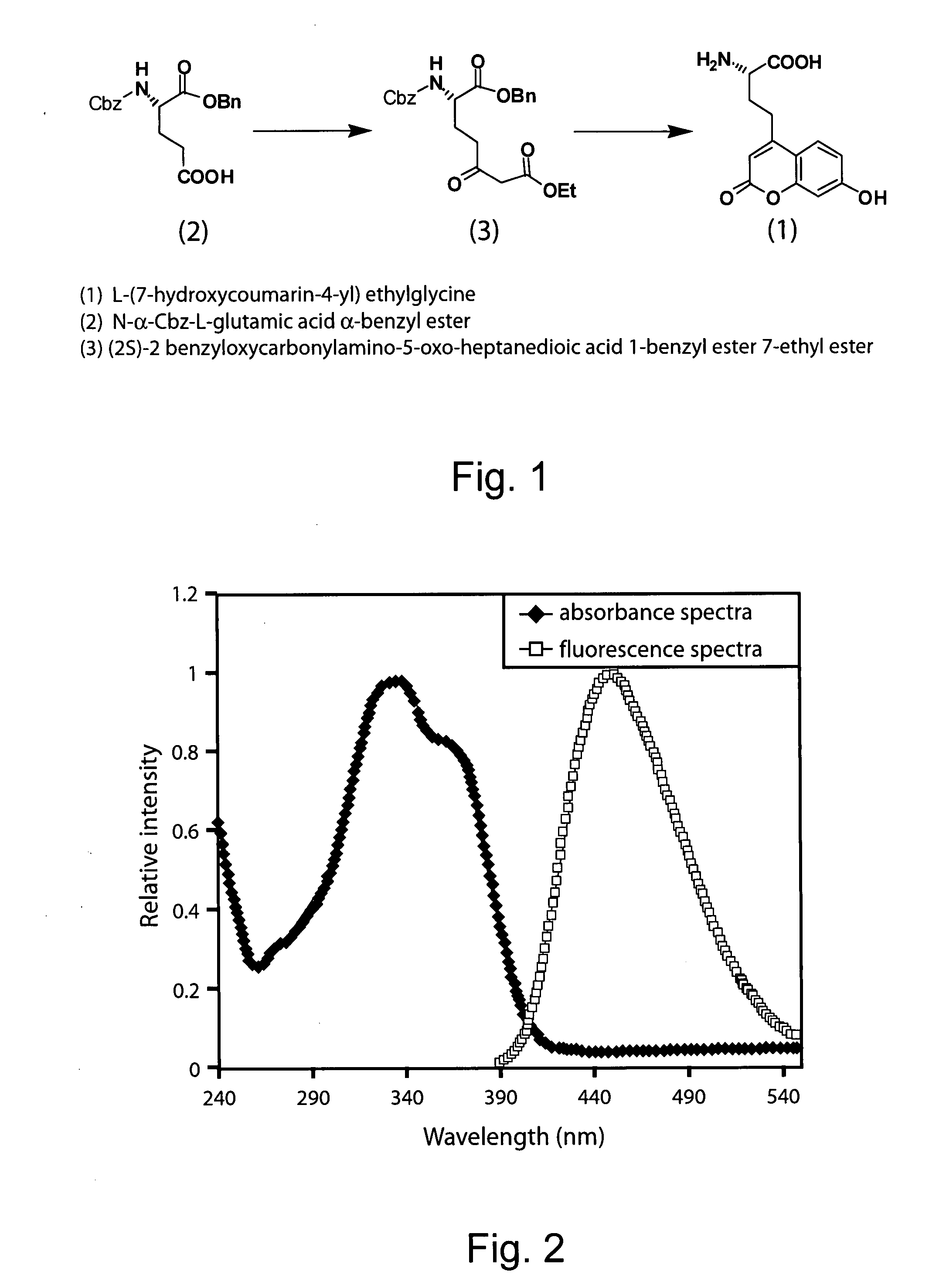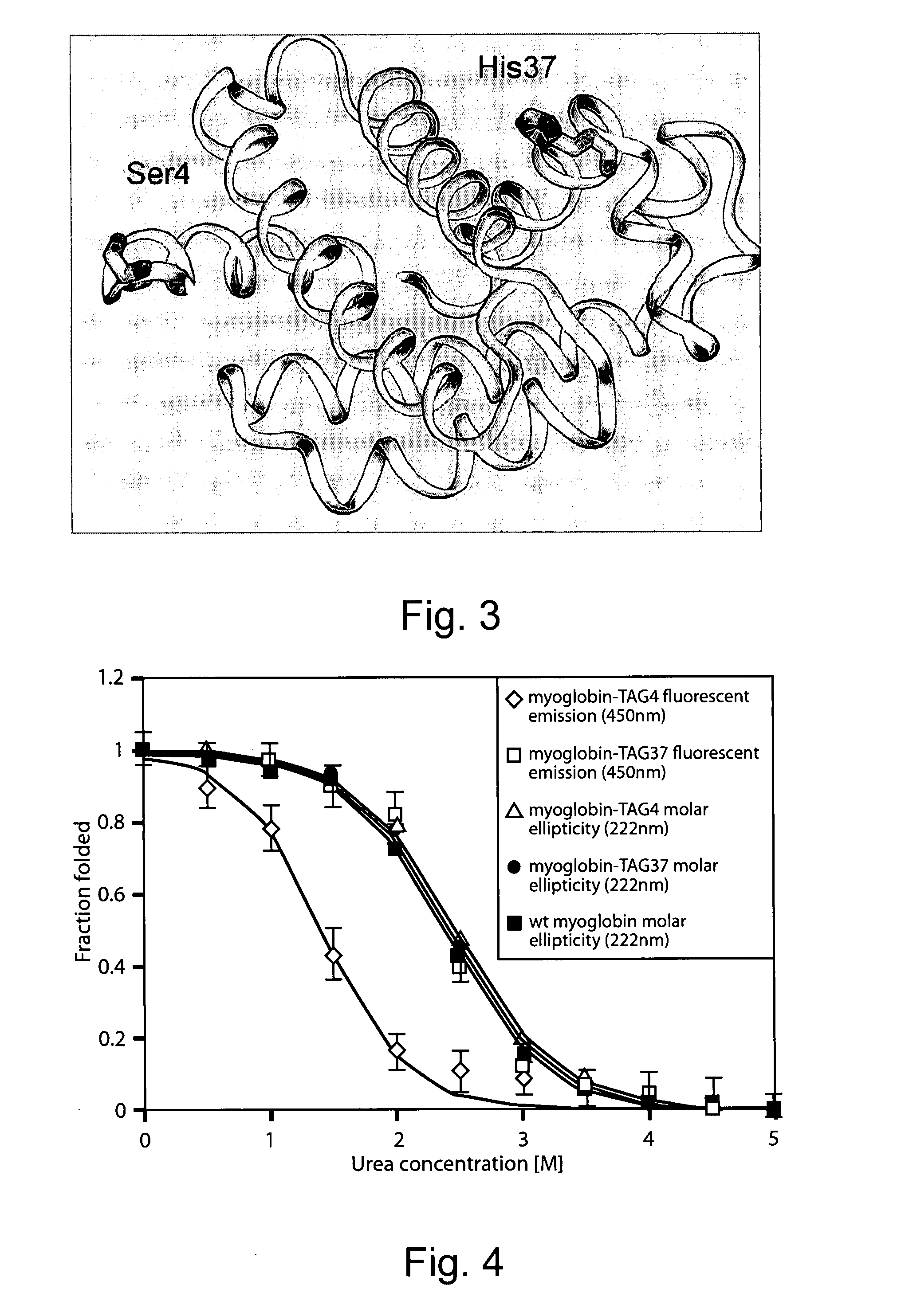Genetically encoded fluorescent coumarin amino acids
a fluorescent coumarin and gene-encoding technology, applied in the field of translation biochemistry, can solve the problems of significant structural perturbations, poor regioselectivity, and general limitation of techniques to uniquely reactive surface accessible residues on isolated proteins
- Summary
- Abstract
- Description
- Claims
- Application Information
AI Technical Summary
Benefits of technology
Problems solved by technology
Method used
Image
Examples
example 1
General Methodologies
[0229] All chemicals were obtained from commercial sources and used without further purification. 1H NMR spectra were recorded on a Bruker AMX-400 multinuclear spectrometer (Bruker BioSpin GmbH, Rheinstetten / Karlsruhe, Germany) with chemical shifts reported relative to tetramethylsilane. Protein mass spectra were acquired at the Scripps Center for Mass Spectrometry (La Jolla, Calif.).
Plasmids and Cell Lines
[0230] Plasmid pBK-lib5 encodes a library of M. jannaschii tyrosyl tRNA synthetase (MjTyrRS) mutants in which residues Tyr32, Leu65, Phe108, Gln109, Asp158 and Leu162 were randomized; in addition, His70 was mutated to Gly, and Ala67 was mutated to either Ala or Gly. Plasmid pREP(2) / YC encodes MjtRNACUATyr, the chloramphenicol acetyltransferase (CAT) gene with a TAG codon at residue 112, the GFP gene under control of the T7 promoter, a mutant T7 RNA polymerase with a TAG codon at residues 1 and 107, and a Tetr marker. Plasmid pLWJ17B3 encodes MjtRNACUATyr u...
example 2
Synthesis of the Unnatural Amino Acid L-(7-Hydroxycoumarin-4-yl) Ethylglycine
[0231] The unnatural coumarin amino acid L-(7-hydroxycoumarin-4-yl)ethylglycine (also written 7-hydroxycoumarin-ethylglycine; see FIG. 1, structure 1) was synthesized by first converting N-α-Cbz-L-glutamic acid α-benzyl ester into the side-chain β-keto ester, which was then reacted with resorcinol in methanesulfonic acid (von Pechmann reaction; Brun et al., Angew. Chem., Int. Ed., (2004) 43:3432-3436) to afford amino acid L-(7-hydroxycoumarin-4-yl)ethylglycine. These steps are described in detail below.
Step 1—Synthesis of Ethyl Magnesium Malonate
[0232] To a stirred aqueous solution of 1.5 M magnesium chloride and 3 M ethyl potassium malonate was added five volumes of isopropanol. After filtration, ethyl magnesium malonate was dried in vacuo.
Step 2—Synthesis of (2S)-2-benzyloxycarbonylamino-5-oxo-heptanedioic acid 1-benzyl ester 7-ethyl ester (FIG. 1, structure 3)
[0233] Z-Glu-Obzl (a N-α-Cbz-L-glutami...
example 3
Genetic Selection of Mutant Synthetase Specific for 7-Hydroxycoumarin-Ethylglycine
[0235] To selectively incorporate 7-hydroxycoumarin-ethylglycine at defined sites in proteins in E. coli, a mutant Methanococcus jannaschii tyrosyl amber suppressor tRNA (MjtRNATyrCUA) / tyrosyl-tRNA synthetase (MjTyrRS) pair was evolved that uniquely specifies 7-hydroxycoumarin-ethylglycine in response to the TAG selector codon.
Library Construction
[0236] To accommodate the large coumarin side chain of the unnatural amino acid 7-hydroxycoumarin-ethylglycine, an MjTyrRS library pBK-lib5 was generated, in which wild-type Methanococcus jannaschii tyrosyl-tRNA synthetase (FIG. 9; SEQ ID NOs: 2 and 3) His70 was mutated to Gly, and Ala67 was fixed as either Ala or Gly to increase the active site size. Six residues, Tyr-32, Leu-65, Phe-108, Gln-109, Asp-158 and Leu-162, in close proximity to bound tyrosine (Kobayashi et al., Nat. Struct. Biol., (2003) 10:425-432; Zhang et al., Protein Sci., (2005) 14:1340-1...
PUM
| Property | Measurement | Unit |
|---|---|---|
| pH | aaaaa | aaaaa |
| mass | aaaaa | aaaaa |
| Tm | aaaaa | aaaaa |
Abstract
Description
Claims
Application Information
 Login to View More
Login to View More - R&D
- Intellectual Property
- Life Sciences
- Materials
- Tech Scout
- Unparalleled Data Quality
- Higher Quality Content
- 60% Fewer Hallucinations
Browse by: Latest US Patents, China's latest patents, Technical Efficacy Thesaurus, Application Domain, Technology Topic, Popular Technical Reports.
© 2025 PatSnap. All rights reserved.Legal|Privacy policy|Modern Slavery Act Transparency Statement|Sitemap|About US| Contact US: help@patsnap.com



